|
SEG Home > History of Saltford > A - Z > Online Museum
The History of Saltford
ONLINE MUSEUM
We have published here a wide-ranging collection of interesting artefacts, articles, images, photographs etc. of life in Saltford.
Saltford is a village settlement that had important associations with the River Avon from the early Iron Age, through the Roman occupation and Medieval period to the Industrial Revolution. Evidence of a much earlier settlement has been suggested by the discovery of Neolithic/Bronze Age artefacts and geophysics evidence of possible roundhouses in the area.
You can gently stroll through Saltford's past by scrolling (strolling) down this and the other pages of this extensive record. We are adding new material on a continuous basis so do re-visit the Online Museum periodically.
We are grateful to everyone who has loaned items (or images) for use in this unique collection that is a showcase of Saltford's illustrious and fascinating past.
BC
It could be that people have lived in Saltford since the Bronze Age or perhaps even earlier; we cannot be sure. The Bronze Age in Britain was a 1,700 year period from around 2,500 BC - 800 BC.
When looking at pre-history time periods it is difficult to exactly define the boundaries and overlap between the last part of the Stone Age (the Neolithic period), the early Bronze Age (c.2,500 BC - 1,100 BC) and the late Bronze Age (c.1,100 BC - 800 BC).
Saltford's oldest artefacts and evidence are from BC (Before Christ) and before the Roman occupation of Britain (from 43 AD). They are as follows:-
Stone Axe Hammer and other pre-historic tools
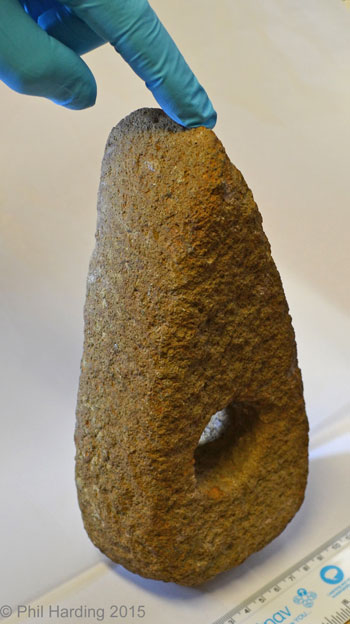
This large stone axe hammer (10"/25cms in length), found in Longreach, Saltford by a boy digging foundations in c.1952, could be over 4,000 years old (from the late Stone Age or early Bronze Age).
Acknowledgements/Information Sources
Photograph: Taken at Bristol Museum by Phil Harding, July 2015, with kind permission of Gail Boyle. Information: 'Bristol Museums, Galleries & Archives'.
Quartzitic Sandstone Tool
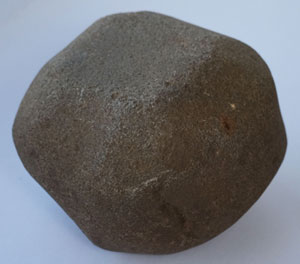
This quartzitic sandstone stone that measures 7cms at its widest diameter was found at a depth below the surface of c.450mm (18") in one of the excavation trenches amongst Roman artefacts including Roman pottery sherds during the archaeological dig undertaken in September 2019 by SEG and BACAS in the Roman coffin field on the south side of Saltford.
The rectangular shaped surfaces shows that this hard stone has been used as a handheld rubbing or polishing tool. Quartzitic sandstone does not occur naturally in Saltford. It is thought such tools were used since at least the Bronze Age. Romans also used such stones as rubbing or polishing tools, e.g., when working or finishing leather or metal items. It is not possible to tell from which period this stone was first used as a tool. A Roman working farm for keeping livestock with workshops for related light industrial purposes is thought to have been present on the site where this stone was found. Lower down the field evidence of roundhouses that could be from the late Bronze Age (1,100 BC - 800 BC) or Iron Age (800 BC - 43 AD) was found during a geophysics survey in 2015.
Earlier stone tools made from flint
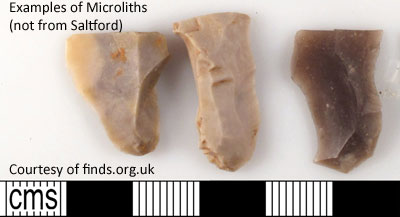
Flint does not occur naturally in Saltford yet small fragments of flint including a microlith* have been found in the fields on the south side of Saltford. Flint was used as a basic cutting hand tool during the stone and bronze ages.
*The microlith found in the same field as the Roman coffin found in 1948 is an undated find recorded in the Bath and NE Somerset Heritage Environment Record. A microlith is a small stone tool usually made of flint or chert. Microliths are typically a centimetre or so in length and half a centimetre wide. These were used to form the points of spears and arrows used for fishing, hunting or as weapons.
Bronze Age Spearhead, Saltford
c.1500 - c.1150 BC
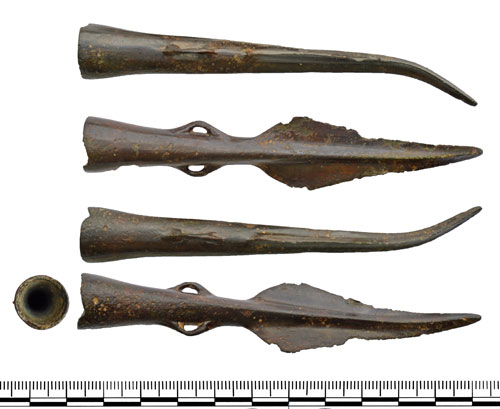
Image courtesy of PAS (see below).
This remarkable Bronze Age copper alloy socketed spearhead over 3,000-3,500 years old was found on the north side of Saltford in 2018/19. It is dated to the Middle Bronze Age c.1500 - c.1150 BC. The spearhead is 105mm (c. 4 1/2") in length and 20mm wide; the socket is circular in cross-section and expands outwards to the aperture (15mm in diameter).
The loops on socketed spearheads such as on this example would have originally been used to help attach and secure the spearhead to the wooden shaft. They also may have been used as suspension loops for some form of tassel or decoration.
Acknowledgements/Information Sources
Finder: Steve Fillingham
Portable Antiquities Scheme (PAS, Unique ID: GLO-3AB9E7): artefact link (2021) - also source of image.
Evidence of roundhouses in Saltford
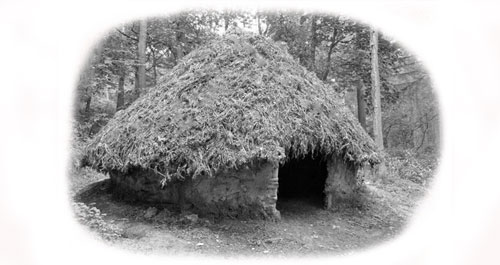
An example of a roundhouse reconstruction.
Evidence from a geophysics survey by Bath & Camerton Archaeological Society (BACAS) of the northern most aspect of Saltford Golf Club (on the south side of the village) in January 2013 revealed "a number of areas where there are also possible round houses" and "an ovoid enclosure with indications of a round house".
Another geophysics survey by BACAS and SEG in October/November 2015 in the field where a Roman coffin was found in 1948 (see Roman Saltford), also on the south side of the village but west of Saltford golf course, revealed "a number of probable round house drip gullies."
These roundhouses could be from the late Bronze Age (1,100 BC - 800 BC) or Iron Age (800 BC - 43 AD); the two bronze socketed axe heads found in Saltford and shown in this Online Museum (next entry below) are possibly further evidence of settlement during those time periods.
Bronze Socketed Axe Heads found in Saltford
Bronze socketed axes came from the late Bronze Age around 1,100 BC - 800 BC so the Saltford bronze axe heads could be as old as 3,000 years old although we cannot know when the axes were deposited in Saltford.
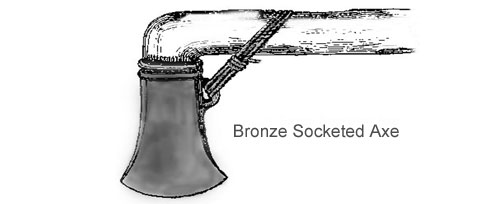
Sketch showing bronze axe head attached to wooden handle.
Axe Head No.1
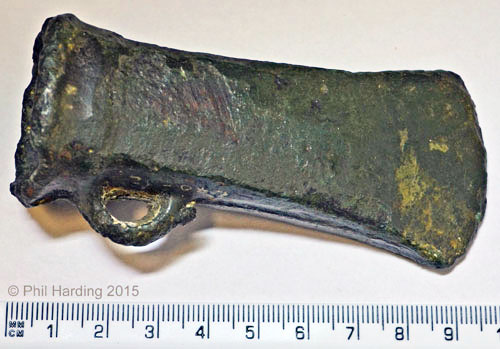
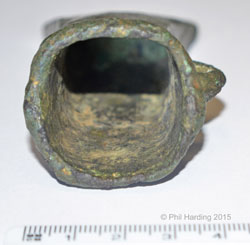 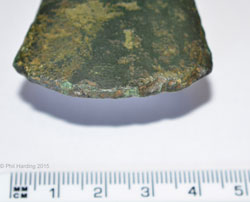
The Bronze Axe Head found in Saltford and kept at Bristol Museum.
Socket and blade shown in detail.
This bronze socketed axe head was acquired by Bristol Museum from Derby Museum in the 1950s. There are no records available to show where in Saltford it was originally found.
Acknowledgements/Information Sources
Photographs: Taken at Bristol Museum © Phil Harding, July 2015, with kind permission of Gail Boyle.
Axe Head No.2
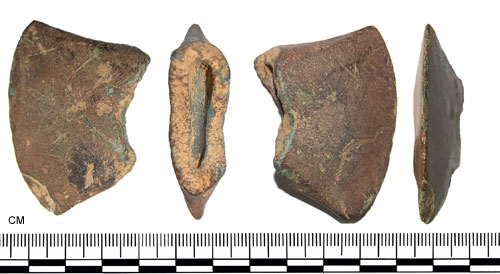
This copper alloy axe blade fragment was found on the south side of Saltford in 2014 by John Durnell.
Acknowledgements/Information Sources
Portable Antiquities Scheme: artefact link (2015).
Return to top of page
The Saltford Carthaginian Coin (300 - 264 BC)
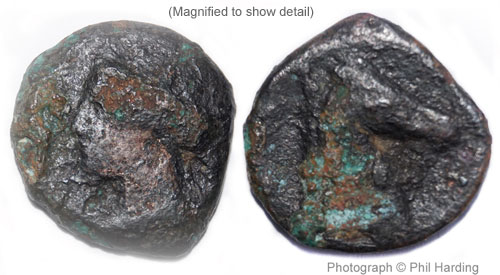
Ref. SHC CC
"the earliest tangible evidence for contact
between the Mediterranean and Saltford"
British Museum, London WC1
(6th March 2015)
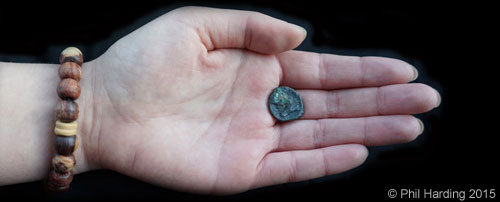
For full details about this important find on the banks of the river Avon after the river flooded and burst its banks in November 2012, please visit the page(s) on the coin >>.
Return to top of page
Iron Age Pottery
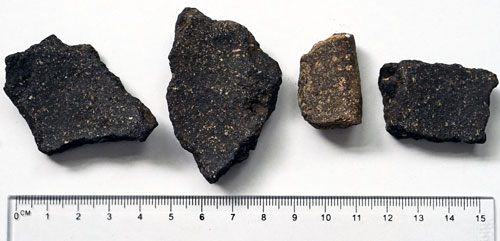
The pottery sherds pictured above from the Iron Age period were found on the south side of Saltford during an archaeological dig in 2018. The thickness of the pottery, colour and its coarse structure with inclusions, i.e. fragments incorporated naturally or added to the clay, is why it has been identified as belonging to the Iron Age period.
Return to top of page
AD
Roman Saltford
"Bath was a flourishing Roman city, and
the country around would be studded
with the villas of the wealthy colonists".
1891 proceedings of the British Archaeological Association (Vol XLVII)
Many Roman artefacts including
have been discovered in Saltford over the years and as recently as 2019. These are featured within our Online Museum here.
The evidence of Roman settlement and dwelling houses of various types and sizes on the eastern side of Somerset and in particular north east Somerset including the city of Bath, is considerable.
Evidence suggests that at least one or two Roman villas and/or, as is most likely on the south side of Saltford, Roman working farms once existed within the current Saltford parish boundary, hence our geophysics survey work and archaelogical digs from in 2015 to 2019 to locate the dwelling(s) on the south side of Saltford which has revealed a farm (possibly at one time a large farm building with workshop buildings of wooden construction). We carried out exploratory excavation digs in 2018 and in 2019, and the results are published below.
The remains of Roman villas had previously been discovered either side of Saltford:-
- West at Keynsham - Two villas have been discovered in Keynsham.
(i) A large and elaborate villa was discovered in 1877 at Durley Hill in Keynsham with ten 4th Century floor mosaics. This is thought to be one of grandest villas ever built in Britain with over 30 rooms, and has even been compared to a small palace. At least 15 additional Roman buildings existed at this site.
(ii) In 1922 a further smaller square 8 room villa including a bathing suite was discovered in Keynsham when foundations were being dug for Fry's chocolate factory (the factory closed in 2011). This was found with two stone coffins containing male and female skeletons.
- East at Newton St Loe - The remains of a Roman villa were uncovered in c.1837 during the construction of the Great Western Railway on the Saltford side of Newton St Loe on ground that slopes gently towards the river Avon, close to the point where the Bath to Bristol road (A4) crosses the railway. Two mosaics were removed, one of which is known as the Orpheus Mosaic and is held by Bristol Museum and Art Gallery.
Saltford's Roman dwellings/buildings
The discovery of numerous Roman artefacts including two stone coffins as shown here in our Online Museum provides strong evidence of Roman habitation in Saltford. An objective of SEG's history project has been to find the location of one or more Roman buildings to help tell the story of Roman life here in Saltford during the Roman occupation of Britain (43 - 430 AD).
In 1949, the year after the Roman stone coffin was found in 1948 complete with the skeleton of a young man in a field on the south side of Saltford, some trial trenches were dug to determine whether there was any other evidence of Roman occupation. The excavations unearthed pottery fragments, coins, nails and utensils as well as 'oyster shells too numerous to record'. There was a suggestion that there may have been a road in this location, but whether this was of Roman origin was not known.
The survey work carried out in 2015 and 2016 at SEG's request and described below was the first time a geophysics survey had been made of this field. The archaeological digs in 2018 and 2019 (reported on below) found a remarkable volume of Romano-British artefacts.
Whilst from our excavation digs there was no evidence of buildings (no floors or stone wall foundations were discovered), in view of the large number of Roman finds at this location it is of course possible that wooden agricultural buildings of Roman origin, e.g. for keeping livestock and related light industrial purposes, were in place in this particular field for which archaeological evidence has long disappeared.
We have described in detail our geophysics survey and excavation work in the Roman coffin field in the information sections below.
Our search for a Roman building (or farm) on the south side of Saltford
A. GEOPHYSICS SURVEYS
For B. Archaeological Digs see below.
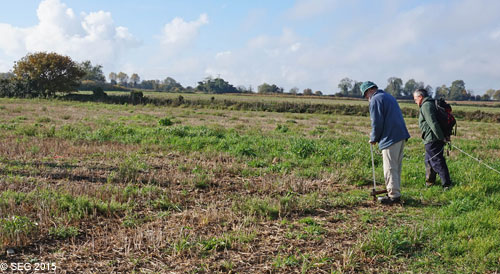
A twin probe resistance meter in use during the
geophysics survey in Saltford, 28 October 2015.
In October/November 2015 Bath and Camerton Archaeological Society (BACAS, since renamed as Bath and Counties Archaeological Society) supported by volunteers from SEG carried out a geophysics survey for a significant section of the Roman coffin field on the south side of Saltford. The available time in 2015 was a major constraint so the geophysics survey was completed the following year over 4.5 days in early November 2016.
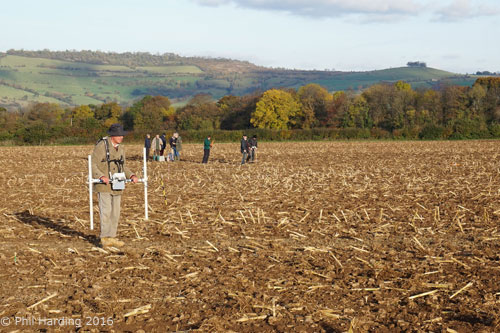
The geophysics survey in Saltford underway again, November 2016.
The survey reports from the 2015 and 2016 surveys can be downloaded at the end of this entry.
The 2015 survey indicated the possible presence of some prehistoric roundhouses in the northern portion of the field. These possible roundhouse drip gullies suggest Iron Age settlement in the area (Note: a late bronze age axe blade was discovered in this field at that location in 2014). Interestingly, possible evidence of roundhouses was found by BACAS in 2013 on a similar latitude due east on Saltford Golf Club land being surveyed in connection with the planning application for a new golf academy.
Of particular interest were signs of what may be a major Roman structure or building complex on higher ground to the southern end of the field (subsequently no building fopundations of stone construction were found from excavations - see below). This site could thus be linked to the Roman coffin that had been found in close proximity to the possible structure. Any Roman structure of this nature in this part of the country would most likely be built of stone butwooden agricultural buildings from the Roman period may have been here. It might be a farm or perhaps a mixed use agricultural/industrial complex; the close proximity to the coffin suggests it might possibly have been of local significance.
Below is an image from day 2 of the November 2016 survey; as can be seen a very large agricultural complex measuring up to approximately 70 metres in length and 40 to 50 metres in width appears to have been discovered. To the left (west) of the complex are two large ditches running east-west and these extend to the far west boundary of the field (and presumably beyond). These might have been for retaining livestock, irrigation, land drainage or some other purpose.
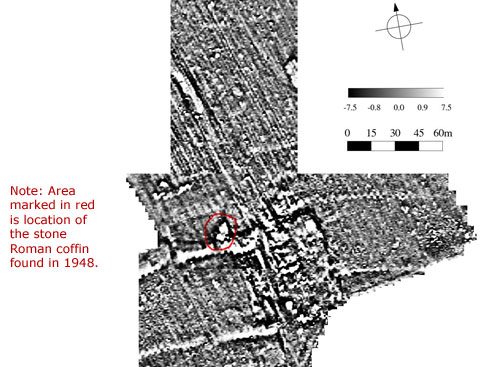
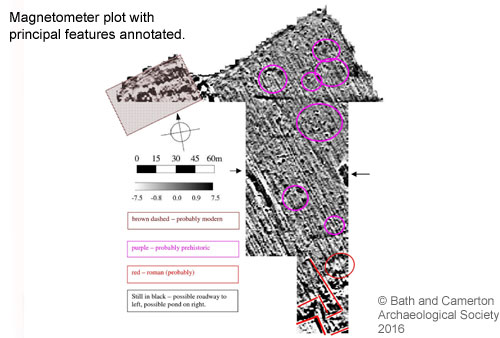
Image from the 2015 survey report of the
magnetometer plot with principal features annotated.
Other findings & acknowledgements from the geophysics surveys
As can be seen from the final 2016 report, in the north western corner of the field an area of magnetic disturbance appears to indicate a structure but magnetometry has not provided a clear image. A trackway running up the west side of the field is also visible over part of its length. There also appears a pair of short, intense strong lines on the east side of the field, approximately 45 metres in from the field margin. It is not obvious what these represent.
In the east portion of the field, a series of east - west lines, unevenly spaced, may be part of an earlier field system, perhaps medieval.
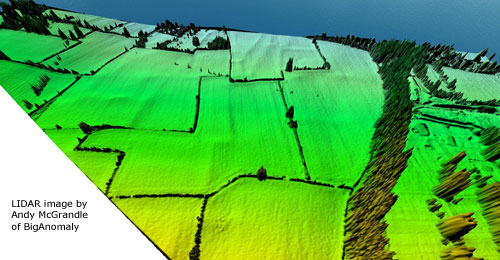
One of the LIDAR images from the survey final report.
Processed data shows Coffin Field & surrounding area.
© BACAS
LIDAR (Light Detection and Ranging) imaging was introduced for the 2016 survey report (courtesy of Andy McGrandle of BigAnomaly). This usefully provides complementary information in the form of landscape archaeology revealing many features of archaeological interest in the surrounding fields including evidence of an earlier and ancient field system, possibly Roman, and other features (mounds and other structures).
SEG is very grateful to the landowner, Adam Stratton, for allowing access to the field, to BACAS for carrying out this geophysics survey, for the assistance of survey volunteers from BACAS and SEG named in the report and to Andy McGrandle of BigAnomaly for the LIDAR imagery.
FOOTNOTE: With the landowner's permission for each survey, the field has been the subject of several metal detection surveys in recent years and these have revealed some bronze Roman coins, and other small bronze items as well as Roman pottery and tile fragments that can be found here in our Online Museum. Due to those surveys the discovery of further coins etc. of any particular new significance or value is not anticipated.
Geophysics reports
The 2016 final geophysics report can be downloaded here:-
The previous 2015 interim geophysics report can be downloaded here:-
B. ARCHAEOLOGICAL DIGS
1st Archaeological Dig (August 2018)
In August 2018 volunteers from the Bath and Counties Archaeological Society (BACAS) and SEG carried out an excavation at this site. The "Archaeological Field Evaluation and Post-Excavation Assessment Report" that records the findings from the excavation and post analysis/assessment of the finds recovered can be downloaded below.
A specific area of the field was targeted for the excavation as the geophysical survey suggested that there might be Romano-British structures in that location. As the report states, finds range in date from the Bronze Age to modern times. The finds comprised: bones (some butchered), ceramic building material, charcoal and coal fragments, daub or burnt clay, flint, Roman coins, pieces of glass, iron and lead, sherds of pottery, stone objects, and slag or clinker.
In summary, numerous artefacts of varying types mostly from the Romano-British period were recovered. Also ceramic building material and Pennant sandstone tiles were found, but no evidence of a building was seen. However, the recovered finds do suggest there is a structure probably a working farm with workshops, yards etc. in the very near vicinity to the position of the 2018 excavated trench.
You can download the Archaeological Field Evaluation and Post-Excavation Assessment Report by BACAS published in May 2019 here:-
Examples of the many Roman pottery sherds can be found in the Roman pottery section below.
2nd Archaeological Dig (September 2019)
SEG once again joined forces with BACAS in September 2019 to investigate whether there were any buildings at the site. We were greatly assisted by local farmer Clive Shipley and his digger and his assistant Phil.
Three main trenches of varying sizes were opened up as well as several smaller trenches around the site (11 in total). In the first trench a large 'pavement' of the local lias stone natural bedrock was found. In the cracks we found many pottery sherds and some hobnails, suggesting that it had been exposed in Roman times. The other two trenches cut across a very large and deep ditch that had been identified by the geophysical survey. This contained large quantities of pottery sherds (of many different types) and sawn animal bones, indicating that they had been butchered.
The assemblage of butchered bones found in the trenches was made up mostly from domestic mammal, sheep/goat, cattle, pig and birds which are the main source of food. 296 cattle knuckle bones that had been cleanly removed from their shafts were found in three trenches; it is possible that the shafts might have been used for producing implements.
Some half-a-dozen Roman coins were found during the course of the dig, but no buildings. Fragments of iron and copper alloy slag or waste was also found. All of the trenches hit shallow bedrock without finding any evidence of stone structures.
Whilst the overall outcome of the dig was disappointing (no floors or stone wall foundations were discovered), in view of the large number of Roman finds at this location it is of course likely that wooden agricultural buildings of Roman origin, e.g. a working farm for keeping livestock with workshops for related light industrial purposes, were in place in this particular field for which archaeological evidence has long disappeared. The structure was, to quote from the "Post-Excavation Assessment of Finds and Results" report for SEG and BACAS by Robin Holley, Director of Archaeology, BACAS, on the 2019 dig, "probably a working farm with workshops and yards, possibly to the west of the 2019 excavations."
SEG is very grateful to the landowner, Adam Stratton, for allowing access to the field, to BACAS for supervising and carrying out the digs and also writing up the reports on the 1st and 2nd digs after analysing the finds, and of course to all the volunteers that took part in the digs including, for the 2nd dig mechanical excavations, Clive Shipley and his assistant Phil.
Roman pottery sherds found in Saltford
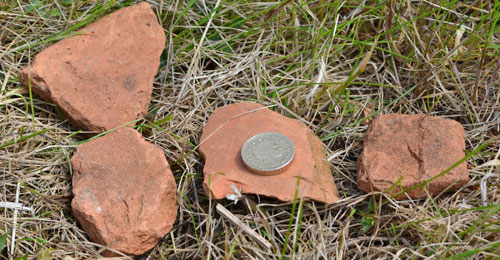
Examples of Roman terracotta fragments of roof tiles
& pots found on south side of Saltford
(Photograph: 2015. £1 coin used for scale.)
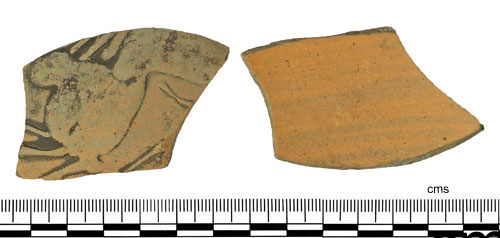
Ref. SHC 006
Fragment from a Roman Nene Valley Colour Coated Ware Beaker (c.100-400AD) found on south side of Saltford in 2016 by Bob Mordle.
Acknowledgements/Information Sources
Portable Antiquities Scheme: artefact link (2016).
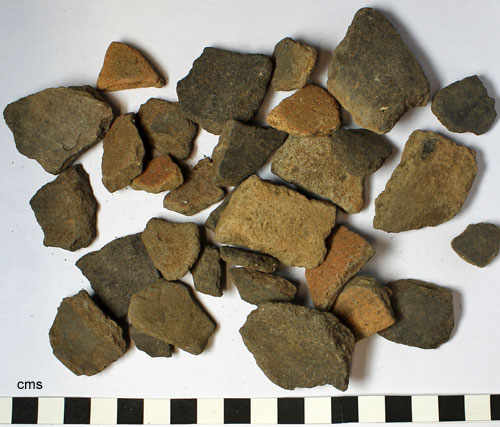
Fragments of Roman South East Dorset Black Burnished Ware (c.43-410AD) found on south side of Saltford in 2016 by Bob Mordle.
Acknowledgements/Information Sources
Portable Antiquities Scheme: artefact link (2016).
SAMIAN WARE: This high-quality tableware, decorated red-gloss pottery, was particularly popular and widespread in the Western Roman Empire from about 50 BC to the early 3rd Century AD.
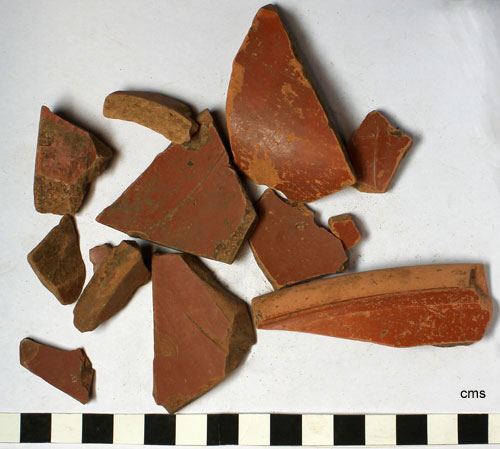
Fragments of Roman Samian Ware (c.43-260AD) found on south side of Saltford in 2016 by Bob Mordle.
Acknowledgements/Information Sources
Portable Antiquities Scheme: artefact link (2016).
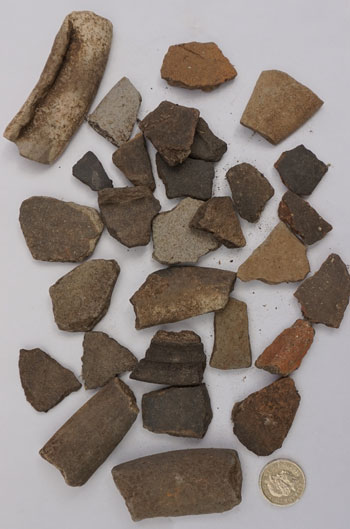
Romano British pottery found on north side
of Saltford in 2015. £1 coin used for scale.
Pottery provided by Bob Mordle.
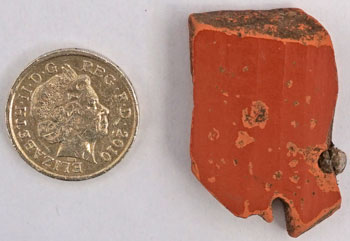
Roman Samian ware pottery with lead repair
found on north side of Saltford in 2015.
£1 coin used for scale.
Pottery provided by Bob Mordle.
Other finds related to Roman habitation
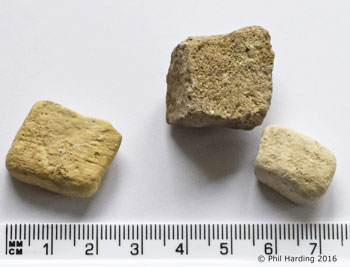
Roman stone tesserae found on south side of Saltford in 2016. Cut stone tesserae were used in Roman decorative mosaic panels and floor mosaics.
Ref. SHC 020
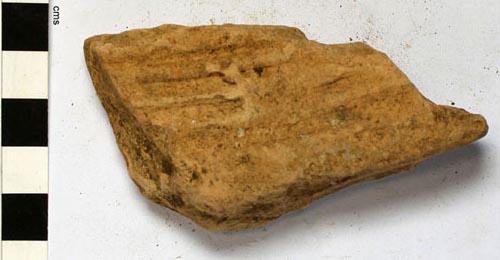
A fragment of Roman flue tile that has linear striation on the surface to adhere plaster, part of one side wall still remains on one edge (c.43-410AD). Creamy buff fabric with grog inclusions. This was found on south side of Saltford in 2016 by Bob Mordle. Such flue tiles were part of Roman underfloor heating systems known as 'hypocaust'.
Acknowledgements/Information Sources
Portable Antiquities Scheme: artefact link (2016).
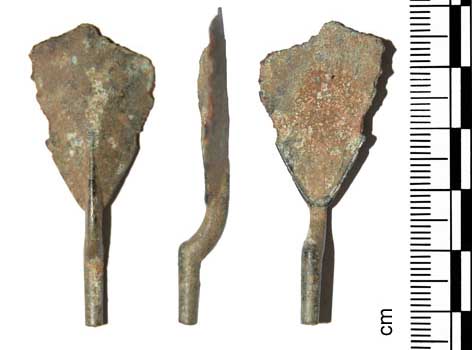
Copper-alloy spoon fragment (Roman) found on south side of Saltford in 2014 by John Durnell.
Acknowledgements/Information Sources
Portable Antiquities Scheme: artefact link (2015).
Examples of Roman pottery found during the Roman coffin field dig of August 2018
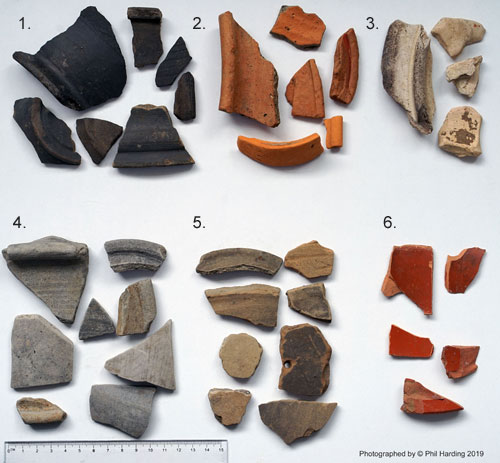
Click here for: enlarged image (opens in new window)
1. Black Burnished Ware; 2. Severn Valley Ware; 3. Oxford Ware 4. Grey Ware; 5. Fawn Fine Ware; and 6. Samian Ware.
Roman brooches & jewellery
Brooch (i)
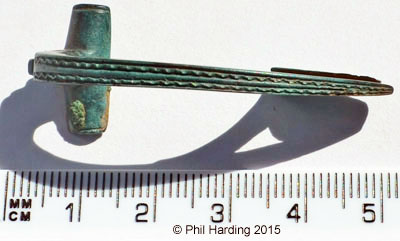
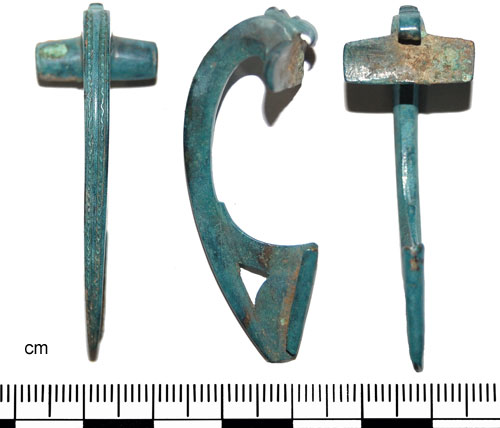
Roman brooch (from different angles) found on
the south side of Saltford in 2014 by John Durnell.
DESCRIPTION OF ROMAN BROOCH:
Copper alloy sprung dolphin brooch, 49mm in length, that has the remains of a rearwards facing hook at the top of the head that would have held the spring. Semi-circular wings project either side of the head, the forward of which are decorated with a recessed vertical band. The front of the brooch is decorated with two wavy lines flanked by a recessed border that runs
down the length of the bow. The catch plate on the reverse is open. Date 43-65AD.
Acknowledgements/Information Sources
Portable Antiquities Scheme: artefact link (2015).
Brooch (ii)
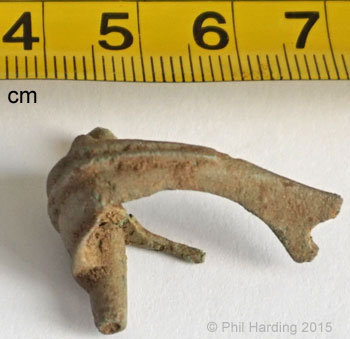
This copper alloy sprung dolphin brooch, 30mm in length, (shown here in uncleaned condition as discovered) was found on the north side of Saltford in 2015. Part of the original pin can still be seen; perhaps the broken pin was the reason for the original loss of this Roman bow brooch.
Acknowledgements/Information Sources
Found by Dave Brennan in September 2015.
Brooch (iii)
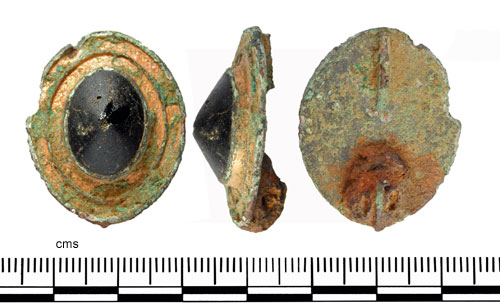
Ref. SHC 001
DESCRIPTION OF ROMAN BROOCH:
Gilded disc (oval) brooch c.200-350AD. Copper alloy oval plate with large raised central cell containing a black glass conical gemstone. The reverse has a mounting for the pin and is encrusted with iron corrosion suggesting that the pin was original made from iron, the catchplate is truncated at its base.
Acknowledgements/Information Sources
Found on the south side of Saltford in 2016 by Bob Mordle.
Portable Antiquities Scheme: artefact link (2016).
Brooch (iv)
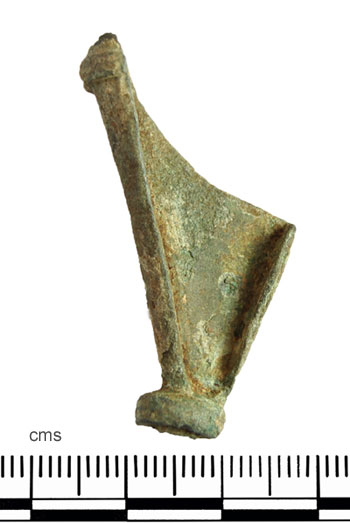
Ref. SHC 003
DESCRIPTION OF ROMAN BROOCH:
Copper alloy roman bow brooch fragment c.43-200AD found on the south side of Saltford in 2016. Consists of the lower third of the bow that has a disc foot decorated with a ring and dot terminal, the catchplate is closed.
Acknowledgements/Information Sources
Found on the south side of Saltford in 2016 by Bob Mordle.
Portable Antiquities Scheme: artefact link (2016).
Roman finger ring
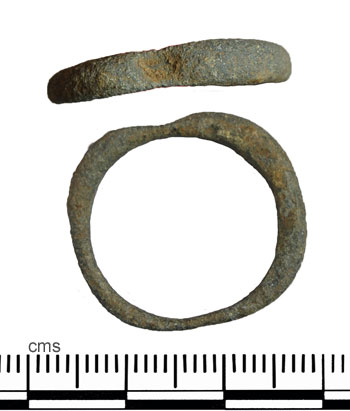
Ref. SHC 002
DESCRIPTION OF RING:
Roman copper alloy finger ring c.43-300AD found on the south side of Saltford in 2016. The hoop of the ring is expanded at the top where there is a small oval recess where a stone would have been mounted; this forms the bezel of the ring. The shoulders are undecorated and narrow from the top edge to the thin rectangular cross-section hoop.
Acknowledgements/Information Sources
Found on the south side of Saltford in 2016 by Bob Mordle.
Portable Antiquities Scheme: artefact link (2016).
Roman pin
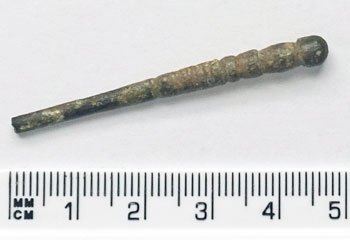
Ref. SHC 004
DESCRIPTION OF PIN:
Roman copper alloy pin (tip missing), 48mm.
Acknowledgements/Information Sources
Found on the south side of Saltford in 2016 by Bob Mordle.
Metalwork (miscellaneous)
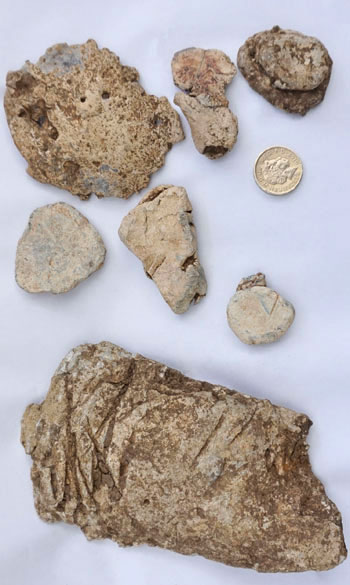
Molten and crushed lead, possibly Roman, found on north side of Saltford in 2015. £1 coin used for scale.
Lead pieces provided by Bob Mordle.
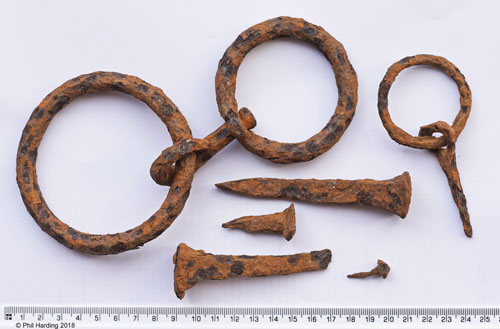
The ancient iron nails and hobnail (bottom right) and iron rings are almost certainly Roman (43-410AD) due to their condition and the location in Saltford where found beneath the top soil.
Iron hobnails were nailed through the soles of Roman boots and sandals to keep the leather footwear together and to prevent the soles from wearing out. It is thought the iron rings found in Saltford may have been used to secure cattle or other livestock.
Acknowledgements/Information Sources
Found on the south side of Saltford in 2016 by Bob Mordle.
Ref. SHC 025
Roman Coins
Below are just 6 of several copper alloy Roman coins found on the south side of Saltford in 2014. Many more have been found in and around Saltford.
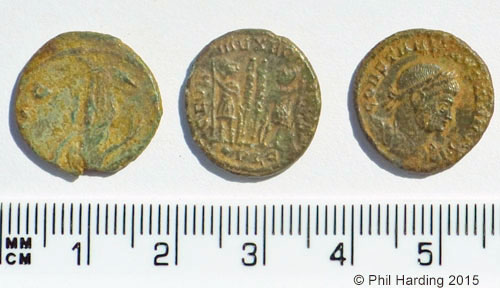
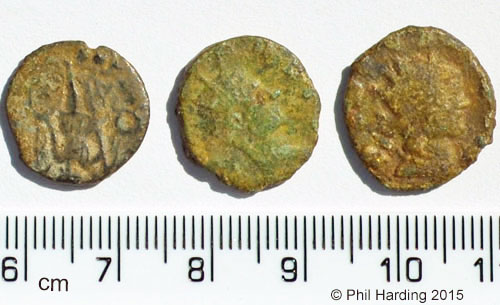
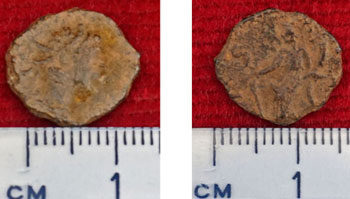
Roman Radiate Claudius II 268-270 AD
found on north side of Saltford in 2015.
Coin provided by Bob Mordle.
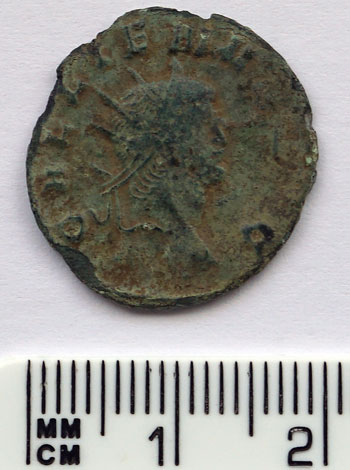
Roman radiate of Gallienus (268 AD) - obverse.
Ref. SHC 026
DESCRIPTION OF ROMAN COIN:
A copper-alloy radiate Gallienus 268 AD. Obverse: Radiate head, reverse depicts a centaur (a mythical creature half, man half horse) drawing bow. Diameter 21mm. Minted in Rome. Radiates are a type of Roman coin which are so named due to the style and prominent radiant crown worn by the emperor depicted.
Found on the north side of Saltford in 2015 by Robert Lynn. Recorded on the Portable Antiquities Scheme with ID No. GLO-1B6E9D.
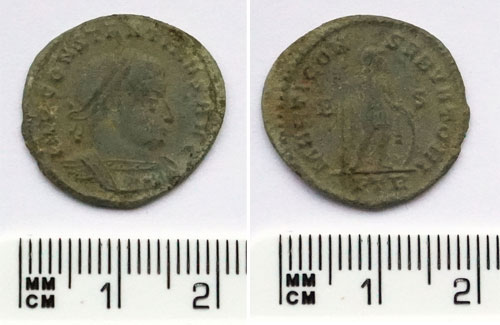
Roman Constantine (313-319 AD) copper alloy coin found on the south side of Saltford in September 2019 by SEG & BACAS during archaeological excavation dig.
Ref. SHC 029
DESCRIPTION OF ROMAN COIN:
A Copper alloy nummus (low value coin) of Constantine I dated to AD 313-319 (period 15) laureate draped and cuirassed bust right, seen from the back CONSTANTINVS PF AVG / Mars standing right in military dress, chlamys across left shoulder, leaning on shield, holding vertical spear in between B-S, MARTI CONSERVATORI in ex PTR.
Note. Constantine I (c.272-337, reigned 306-337) also known as Constantine the Great became emperor after his father's death in 306; he was acclaimed by his army at Eboracum (York, England). The first Roman emperor to convert to Christianity, he made Christianity the main religion of Rome. He built a new imperial residence at the city of Byzantium and re-named the city as Constantinople (now Istanbul), which became the most powerful city in the world at the time.
Acknowledgements/Information Sources
Portable Antiquities Scheme: artefact link (2019)
https://en.wikipedia.org/wiki (2021)
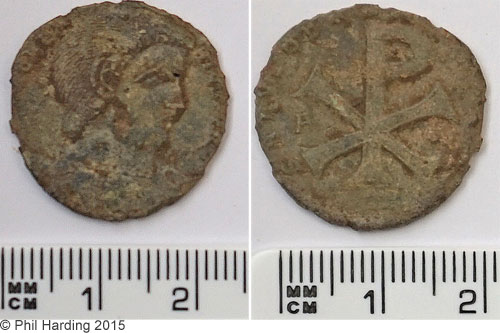
Roman Magnentius (350-353 AD) copper alloy coin found on the north side of Saltford in 2015 by Bob Mordle.
Ref. SHC 013
DESCRIPTION OF ROMAN COIN:
A copper-alloy nummus (coin) of Magnentius dating to the period AD 350-353. Right facing draped portrait of emperor showing no head gear. [DN MAGNEN]-TIVS [PF AVG] / Large 'Chi Rho' symbol with A and W either side. SALVS [DD NN AVG ET CAES]
Note. The 'Chi Rho' symbol on the reverse is an early Christian symbol. It is formed by superimposing the first two (capital) letters chi and rho (XP) of the Greek word for Christ. Although not technically a Christian cross, the Chi Rho reflects the crucifixion of Jesus and his status as the Christ. Chi Rho symbols were used in early Christianity and appear in the Roman
catacombs (human-made subterranean burial places). Constantine I (Roman Emperor 306-337 AD) used this symbol as part of a military standard.
Acknowledgements/Information Sources
Portable Antiquities Scheme: artefact link (2015)
https://en.wikipedia.org/ (2015)
Roman Coffins and human remains
To date two Roman stone coffins have been discovered in Saltford, in 1901 and 1948, and a coffin was discovered south west of Folly Wood just within the Parish of Corston in 1890. The shattered remains of a skull, thought to be Roman, was also found in Saltford in 1951.
It is of course possible that other Roman coffins were discovered in Saltford in centuries past but at the time they were removed and/or broken up without any public record. Roman funerary practices included both burial and cremation; some of the Roman pottery fragments found in Saltford may well be the broken remains of cremation urns.
Roman Coffin discovered in 1890 (on Saltford/Corston border)
The stone coffin found near Folly Wood in Lower Botmore field, Corston, in 1890 was rediscovered in 1957 and destroyed.
The 1891 proceedings of the British Archaeological Association (Vol XLVII) records that this coffin was formed from a block of Bath oolite and was found just 7 inches beneath the surface. The BAA records that "when the lid was removed, a skeleton, presumably of a woman, was exposed to view. It was in fairly good preservation and the body had evidently occupied the whole cavity in the stone, which measured 5ft. 6in. in length."
Near the feet was a brown, powdery substance (presumably the remains of leather sandals worn at the time of burial) and a few small corroded iron nails or studs (smaller than those associated with heavier military sandals worn by Roman soldiers).
The British Archaeological Association account also reports that near the spot where the coffin was found a small piece of dark pottery was found, possibly third or fourth century. According to the BAA report "at that time Bath was a flourishing Roman city, and the country around would be studded with the villas of the wealthy colonists."
The British Archaeological Association stated that "it is not unlikely that this internment was in the private grounds of some country villa."
Further details about this coffin discovery can be found on the HER website: Link to HER - ID1036.
The details and photographs of the two Saltford coffins are as follows:-
Roman Coffin discovered in 1901
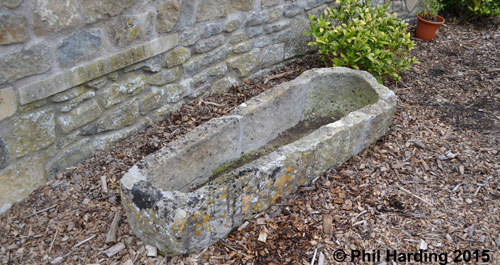
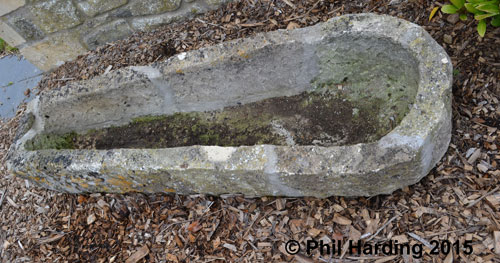
The Roman coffin discovered in 1901. It has been repaired.
© Phil Harding 2015
The first was discovered in 1901 in a narrow strip of plantation leading out of the garden of Saltford House (north side of Saltford) with a broken lid, in a shallow grave. The Heritage Gateway B&NES HER (HER No. MBN1250) records that Mr Stiles of 2 Collins Buildings, High St,
Saltford found the coffin when excavating the post hole for a field gate. The find was reported by Colonel Rolleston of Saltford House.
The coffin measured 1.6m long x 0.5m wide and contained the skeleton of a child along with fragments of small nails (possibly from sandals or shoes).
Roman Coffin discovered in 1948
The other stone coffin was discovered in a field to the west of Longwood (south side of Saltford) on 15th September 1948 during trenching around an elm tree stump prior to its removal. The coffin was complete with (broken) lid and contained a skeleton.
Experts at the time (Mr and Mrs Martin A C Hinton*) said the skeleton was that of a young man, about 20 years old, about 5ft 6in tall, or a little less, and "to have been healthy and vigorous" with teeth in perfect condition. What happened to the skeleton after it was examined by experts is not known.
*To read about the link between this coffin, Mr Martin Hinton, and the Piltdown Man Hoax see footnote.
The stone coffin was made from a block of Bath Oolite stone. The coffin had a barrel-shaped bottom and in addition to the skeleton contained a few scraps of indeterminate pottery, whilst at the foot was some clinched-over iron nails, probably from sandals, and a piece of iron measuring 2 inches x 1 1/2 inches x 3/4 inch. According to the 1950 archaeological report (see below) round-headed coffins found in Somerset like this example were used from the 2nd half of the 2nd century until well into the 4th century.
The coffin was removed to become a plant container in the garden of Wick House Farm but in the 1980s was taken away and buried elsewhere in Saltford. The History of Saltford Team understand the coffin was buried in the wood at Longwood, directly east of its original location, but that it was possibly already broken up prior to disposal.
To download and read the 1950 report "Roman Burial and other Remains at Wickhouse Farm, Saltford, Keynsham Manor Estate" written by F W Jefferies for the Somerset Archaeological Society about the coffin and other Roman artefacts found in 1948, click here:
1948 photographs of the Roman coffin (in situ) discovered west of Longwood (at Wickhouse Farm)
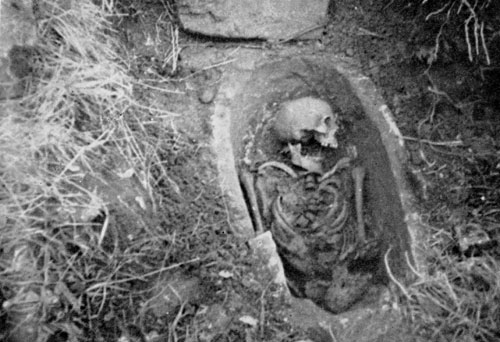
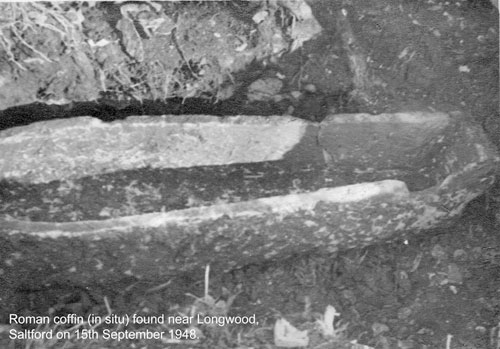
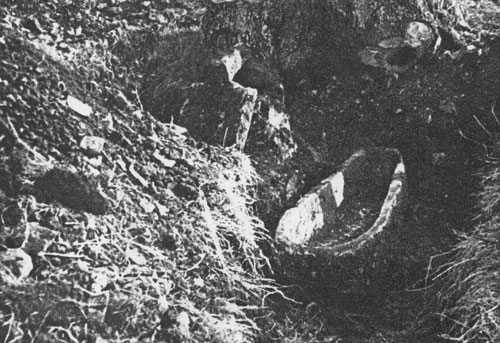
Acknowledgements/Information Sources
British Archaeological Association (Vol XLVII) (1891 proceedings).
'A History of Saltford Village' by Percy Simms (1976).
1948 photograph of skeleton in coffin and associated text from "Roman Burial and other Remains at Wickhouse Farm, Saltford, Keynsham Manor Estate" by F W Jefferies, 1950.
1948 photographs of coffin kindly supplied by Jill Coles.
Roman skull discovered in 1951
A probable Roman burial was also found in 1951 during excavation of land prior to new housing development. Only a shattered skull was found 2 feet below the surface. In the same trench were sherds of Romano-British pottery, nails and a piece of lead. The location of this find (ST 680 677) is west of the child's Roman coffin found in 1901.
Acknowledgements/Information Sources
www.heritagegateway.org.uk
Return to top of page
Footnote: Saltford's Roman Coffin, Mr Hinton and the mystery of the Piltdown Man Hoax...
The zoologist and archaeologist who studied and described the condition of the Roman skeleton (that of a 20 year old man) found in a stone coffin in Saltford in 1948 were Martin A C Hinton (1883-1961) and his wife. The wife in question was most probably Hinton's second wife, Dr Dina Portway Dobson a 'distinguished archaeologist', who he married in 1949 the year of his retirement to Wrington, Somerset; his first wife Jane had died in 1948. The description of Saltford's Roman skeleton was provided by "Mr and Mrs Martin A. C. Hinton" and published in 1950 in an official report of the find for the Somerset Archaeological Society.
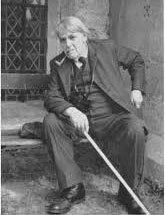 Martin A C Hinton, however, is one of the suspects for the infamous paleoanthropological hoax, Piltdown Man, that was perpetrated in 1908-1912 but did not come to light as a forgery until some 40 years later in the 1950s. The link to Hinton as a possible perpetrator was not made until after his death. Martin A C Hinton, however, is one of the suspects for the infamous paleoanthropological hoax, Piltdown Man, that was perpetrated in 1908-1912 but did not come to light as a forgery until some 40 years later in the 1950s. The link to Hinton as a possible perpetrator was not made until after his death.
Piltdown Man was a composite of an altered human skull and ape jawbone planted, and subsequently 'discovered', at a dig in Piltdown, Sussex, in 1908-12 and presented as a missing link between man and ape. A trunk belonging to Hinton left in storage at the Natural History Museum and found in 1970 contained animal bones and teeth carved and stained in a manner similar to the Piltdown finds. This was some 9 years after Hinton's death and subsequently raised questions about his involvement in the deception.
One theory concerning Hinton's involvement is as follows:-
(source: http://www.britannica.com/topic/
Piltdown-man#ref374472)
In 1996, two decades after a trunk marked with the initials M.A.C.H. had been discovered in storage at the British Museum (Natural History), bones found in the trunk were analysed. The British paleontologists Brian Gardiner and Andrew Currant found that they had been stained in the exact same way as the Piltdown fossils. The trunk apparently had belonged to Martin A.C. Hinton, who became keeper of zoology at the British Museum (Natural History) in 1936. Hinton, who in 1912 at the time of the original discovery was working as a volunteer at the museum, may have treated and planted the Piltdown
bones as a hoax in order to ensnare and embarrass Arthur Smith Woodward. Woodward was keeper of the British Museum's paleontology department and it was he who announced the find at a meeting of the Geological Society of London in 1912. Apparently Woodward had rebuffed Hinton's request for a weekly wage. It is presumed that Hinton used the bones in the steamer trunk for practice before treating the bones used in the actual hoax.
The Piltdown hoax is infamous for the attention paid to the issue of human evolution, and the length of time (40 years) that elapsed from its original discovery to its full exposure as a forgery. The identity of the Piltdown forger remains unknown, but suspects have included Martin A. C. Hinton, Charles Dawson, Pierre Teilhard de Chardin, Arthur Keith, Horace de Vere Cole and even Arthur Conan Doyle.
SEG is not claiming that Martin A C Hinton was a perpetrator of the hoax but is reproducing information already in the public domain concerning his possible involvement in this mystery. An article in the New Scientist (2.7.1981) by L. Harrison Matthews stated that Hinton during discussions with Dina Dobson and BBC producers in Bristol in c.1953 did say that he knew that the forgery had been done by someone in the British Museum (Natural History) but that he could not reveal the name as the man was still alive. Martin Hinton and Dina Dobson took this secret to their graves.
Information sources (October 2015):
en.wikipedia.org/wiki/
Piltdown_Man
www.britannica.com/topic/
Piltdown-man#ref374472
New Scientist, 2.7.1981
Return to top of page
See next page for 5th - 16th Centuries >>

© Saltford Environment Group
W3C compliant website. Web page designed and produced by Phil Harding.
|



















































 Martin A C Hinton, however, is one of the suspects for the infamous paleoanthropological hoax, Piltdown Man, that was perpetrated in 1908-1912 but did not come to light as a forgery until some 40 years later in the 1950s. The link to Hinton as a possible perpetrator was not made until after his death.
Martin A C Hinton, however, is one of the suspects for the infamous paleoanthropological hoax, Piltdown Man, that was perpetrated in 1908-1912 but did not come to light as a forgery until some 40 years later in the 1950s. The link to Hinton as a possible perpetrator was not made until after his death.
